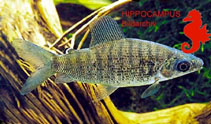| Diagnosis: |
Dorsal spines (total): 0-0; Dorsal soft rays (total): 24-26; Anal spines: 0-0; Anal soft rays: 12-16. Diagnosis: Within the Congo River basin, Distichodus fasciolatus can be distinguished from D. affinis, D. altus, D. decemmaculatus, D. noboli, D. notospilus and D. teugelsi by its higher total number of lateral lina scales, 61-70 vs. less than 46 in the six other species, and from D. maculatus by the absence of large, dark spots all over the body, instead of 13-20 vertical dark bars, and a higher number of dorsal fin rays, 24-26, vs. 19-21 (Ref. 96324). It can be distinguished from D. antonii by its inferior mouth, vs. terminal, and its higher number of scales between the lateral line and the dorsal fin, 13-16 vs. 10-12; from D. lusosso by its inferior mouth, vs. terminal, its feebly compressed snout, vs. distinctively prolonged, and its higher number of dark vertical bars along the body, at least in specimens larger than 150 mm standard length, 13-20 vs. 6-8; from D. sexfasciatus by its higher number of teeth on the outer row of both jaws, 20-30 vs. 12-18, its higher number of dark vertical bars on the flanks, at least in specimens larger than 150 mm standard length, 13-20 vs. 6-8, and its brownish-yellowish colouration vs. orange-reddish to red (Ref. 96324). Moreover, Distichodus fasciolatus can be differentiated from both the D. atroventralis complex and D. langi by its lower number of pelvic fin rays, 10, exceptionally 11, vs. 11, exceptionally 10 for the D. atroventralis complex and always 11 for D. langi; from the D. atroventralis complex by its higher number of dark vertical bars, at least in specimens larger than 150 mm standard length, 13-20 vs. 6-9, and presence of pale pelvic fins, at least in specimens larger than 200 mm standard length, vs. blackish; and from D. langi by a combination of characteristics: 24-26 total dorsal fin rays, vs. 26-28, and a lower head depth, 35.9-62.9% of head length for specimens of comparable size, vs. 67.4-69.4% of head length (Ref. 96324).
Description: Body relatively shallow; dorsal head profile straight, dorsal body outline concave from posterior to head to end of dorsal fin, straight from end of dorsal to adipose fin, and convex from adipose to caudal fin; ventral head profile straight, concave from posterior to head to end of anal fin, and convex from end of anal to caudal fin (Ref. 96324). Head compressed with nasal openings relatively closely set, 8.1-22.0% of head length, and head relatively shallow, 35.9-62.9% of head length, although these characteristics are positively allometric; mouth inferior; posterior edge of maxillary not passing nostrils; two rows of bicuspid teeth in each jaw (Ref. 96324, 122092). Origin of dorsal fin well in front of pelvic fin origin along vertical axis; distal margin of dorsal fin straight or slightly concave, distal margin of anal fin straight to slightly convex; base and distal end of pelvic fin relatively close to vent, although these distances are positive allometric, 18.6-25.8% of standard length and 2.1-5.7% of standard length respectively; pectoral and pelvic fin rays decreasing in length from outer to inner fin margin; adipose fin approximately half-way between dorsal and caudal fins; caudal peduncle deeper then long or as deep as long; caudal fin forked with superior lobe slightly pointed and inferior lobe rounded, covered with numerous small scales except for the translucent distal area (Ref. 96324).
Colouration: Small-sized specimens, 122-150 mm standard length, in vivo are brown-yellowish on the flanks with copper-coloured reflections and with 13-20 dark vertical bars on the flanks; dorsal fin scattered with many small, dark spots; caudal fin with a discrete black outer edge; adipose fin with no or only a very thin greyish distal margin; pectoral fins pale; pelvic fins generally pale, sometimes with slightly darker distal margins; dark spot above the pectoral fin and at the base of the caudal fin; larger specimens, about 300 mm standard length, are brownish, the transverse bars on the flanks as well as the dark spots above the pectoral fin and the root of the caudal fin can become vague but the marks on the dorsal fin clearly remain (Ref. 96324). Small preserved specimens are brownish with a silvery whitish belly; larger specimens, about 450 mm standard length, are uniformly brownish (Ref. 96324). |

